

The Stranger (novel) The Outsider or The Stranger (French: L’Étranger) is a novel by Albert Camus published in 1942.
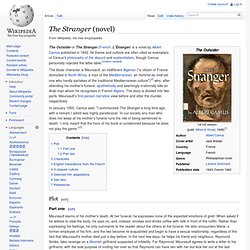
Its theme and outlook are often cited as exemplars of Camus's philosophy of the absurd and existentialism, though Camus personally rejected the latter label. [citation needed] The titular character is Meursault, an indifferent Algerian ("a citizen of France domiciled in North Africa, a man of the Mediterranean, an homme du midi yet one who hardly partakes of the traditional Mediterranean culture")[2] who, after attending his mother's funeral, apathetically and seemingly irrationally kills an Arab man whom he recognises in French Algiers. The story is divided into two parts: Meursault's first-person narrative view before and after the murder, respectively. Existential therapy. Background[edit]
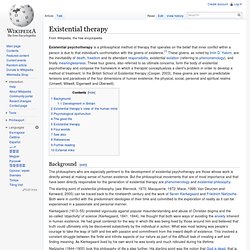
Existential therapy. Mind games. The term mind games refers to three main categories of human behaviour: a largely conscious struggle for psychological one-upmanship, often employing passive–aggressive behavior to specifically demoralize or empower the thinking subject, making the aggressor look superior; also referred to as "power games".[1]the unconscious games played by people engaged in ulterior transactions of which they are not fully aware, and which transactional analysis considers to form a central element of social life all over the world.[2]mental exercises designed to improve the functioning of mind and/or personality; see also brain teasers or puzzles.[3] Conscious one-upmanship[edit] The serious sportsman will also be prepared to meet a variety of gambits and head-games from their rivals, attempting meanwhile to tread the fine line between competitive psychology and paranoia.[7] Unconscious games[edit] Mental exercises[edit] Mind games for self-improvement fall into two main categories.
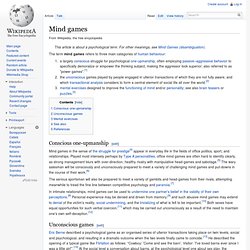
Passive-aggressive behavior. Passive-aggressive behavior is the indirect expression of hostility, such as through procrastination, sarcasm, hostile jokes, stubbornness, resentment, sullenness, or deliberate or repeated failure to accomplish requested tasks for which one is (often explicitly) responsible.
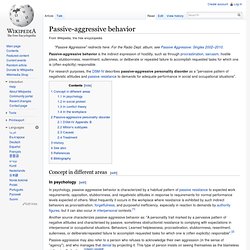
Passive-aggressive behavior. Narcissistic parent. A narcissistic parent is a parent affected by narcissism or narcissistic personality disorder.
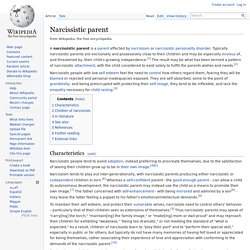
Typically narcissistic parents are exclusively and possessively close to their children and may be especially envious of, and threatened by, their child's growing independence.[1] The result may be what has been termed a pattern of narcissistic attachment, with the child considered to exist solely to fulfill the parents wishes and needs.[2] Narcissistic people with low self esteem feel the need to control how others regard them, fearing they will be blamed or rejected and personal inadequacies exposed. They are self absorbed, some to the point of grandiosity; and being preoccupied with protecting their self image, they tend to be inflexible, and lack the empathy necessary for child raising.[3] §Characteristics[edit] Narcissistic people tend to avoid adoption, instead preferring to procreate themselves, due to the satisfaction of seeing their children grow up to be in their own image.[4][5]
Freud's *The Interpretation of Dreams* Chapter One Sections A, B, and C. Back to Psych Web Home Page Back to Table of Contents for The Interpretation of Dreams In the following pages I shall demonstrate that there is a psychological technique which makes it possible to interpret dreams, and that on the application of this technique every dream will reveal itself as a psychological structure, full of significance, and one which may be assigned to a specific place in the psychic activities of the waking state.
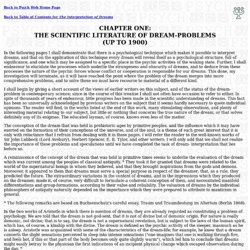
Further, I shall endeavour to elucidate the processes which underlie the strangeness and obscurity of dreams, and to deduce from these processes the nature of the psychic forces whose conflict or cooperation is responsible for our dreams. Folie à deux. Folie à deux (/fɒˈli ə ˈduː/; French pronunciation: [fɔli a dø]; French for "a madness shared by two"), or shared psychosis, is a psychiatric syndrome in which symptoms of a delusional belief are transmitted from one individual to another.[1] The same syndrome shared by more than two people may be called folie à trois, folie à quatre, folie en famille or even folie à plusieurs ("madness of many").

Recent psychiatric classifications refer to the syndrome as shared psychotic disorder (DSM-IV) (297.3) and induced delusional disorder (F.24) in the ICD-10, although the research literature largely uses the original name. The disorder was first conceptualized in 19th-century French psychiatry by Charles Lasègue and Jean-Pierre Falret and so also known as Lasègue-Falret Syndrome.[2][3] Presentation[edit] Brief psychotic disorder. Brief psychotic disorder is a period of psychosis whose duration is generally shorter, non re-occurring, and not caused by another condition.

The disorder is characterized by a sudden onset of psychotic symptoms, which may include delusions, hallucinations, disorganized speech or behavior, or catatonic behavior. The symptoms must not be caused by schizophrenia, schizoaffective disorder, delusional disorder or mania in bipolar disorder. They must also not be caused by a drug (such as amphetamines) or medical condition (such as a brain tumor). The term bouffée délirante describes an acute nonaffective and nonschizophrenic psychotic disorder, which is largely similar to DSM-III-R and DSM-IV brief psychotic and schizophreniform disorders.[1]
Wilhelm Stekel. Wilhelm Stekel (March 18, 1868 – June 25, 1940) was an Austrian physician and psychologist , who became one of Sigmund Freud 's earliest followers, and was once described as "Freud's most distinguished pupil.

" [ 1 ] According to Ernest Jones , "Stekel may be accorded the honour, together with Freud, of having founded the first psycho-analytic society"; while he also described him as "a naturally gifted psychologist with an unusual flair for detecting repressed material. " [ 2 ] He later had a falling-out with Freud, who announced in November 1912 that 'Stekel is going his own way'. [ 3 ] His works are translated and published in many languages. Career [ edit ] Born in Boiany , Bukovina , he wrote a book called Auto-erotism: A Psychiatric Study of Onanism and Neurosis , first published in English in 1950. Id, ego and super-ego. Although the model is structural and makes reference to an apparatus, the id, ego and super-ego are purely symbolic concepts about the mind and do not correspond to actual somatic structures of the brain (such as the kind dealt with by neuroscience).
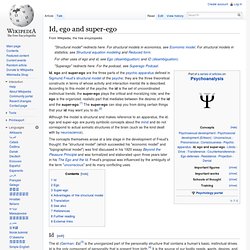
The concepts themselves arose at a late stage in the development of Freud's thought: the "structural model" (which succeeded his "economic model" and "topographical model") was first discussed in his 1920 essay Beyond the Pleasure Principle and was formalized and elaborated upon three years later in his The Ego and the Id. Freud's proposal was influenced by the ambiguity of the term "unconscious" and its many conflicting uses.
Psychodynamics. Psychodynamics, also known as dynamic psychology, in its broadest sense, is an approach to psychology that emphasises systematic study of the psychological forces that underlie human behavior, feelings, and emotions and how they might relate to early experience. It is especially interested in the dynamic relations between conscious motivation and unconscious motivation.[1] The term psychodynamics is also used by some to refer specifically to the psychoanalytical approach developed by Sigmund Freud (1856–1939) and his followers.
Freud was inspired by the theory of thermodynamics and used the term psychodynamics to describe the processes of the mind as flows of psychological energy (libido) in an organically complex brain.[2] Object relations theory. Object relations theory within psychoanalytic psychology describes how experience affects unconscious predictions of others' social behaviors, with repeated experiences of the caretaking environment forming internalized images, which usually depict one's mother, father, or primary caregiver,[1] and later experiences only somewhat reshaping these early images.[2] Object relations theory further holds that the infant mind initially comprehends objects by their functions, which are termed "part objects,"[2] which in a "good enough" "facilitating environment" eventually become a comprehension of whole objects that corresponds to tolerance of ambiguity.[2] Object relations theory derives from psychodynamic theory.
History[edit] Otto Rank, coiner of the term "pre-Oedipal," was the first to create a modern theory of "object relations" in the late 1920s. Freud originally identified people in a subject's environment with the term "object" to identify people as the object of drives. Erikson's stages of psychosocial development. Erikson's stages of psychosocial development, as articulated by Erik Erikson, is a psychoanalytic theory which identifies eight stages through which a healthily developing human should pass from infancy to late adulthood. In each stage, the person confronts, and hopefully masters, new challenges. Each stage builds upon the successful completion of earlier stages.
The challenges of stages not successfully completed may be expected to reappear as problems in the future. Psychodynamics. Energy (psychological) Mental or psyche energy or activity is the concept of a principle of activity powering the operation of the mind or psyche . Many modern psychologists or neuroscientists would equate it with increased metabolism in neurons of the brain. Philosophical accounts [ edit ] Erikson's stages of psychosocial development. Mania. Mania varies in intensity, from mild mania (hypomania) to full-blown mania with extreme energy, racing thoughts, and forced speech.[4] Standardized tools such as Altman Self-Rating Mania Scale[5] and Young Mania Rating Scale[6] can be used to measure severity of manic episodes. Because mania and hypomania have also been associated with creativity and artistic talent,[7] it is not always the case that the clearly manic bipolar person needs or wants medical help; such persons often either retain sufficient self-control to function normally or are unaware that they have "gone manic" severely enough to be committed or to commit themselves.
Manic persons often can be mistaken for being on drugs or other mind-altering substances. Classification[edit] Mixed states[edit] The mixed state can put a patient at greater suicide risk. Schizotypal personality disorder. Fiction: Symbols and Signs. For the fourth time in as many years, they were confronted with the problem of what birthday present to take to a young man who was incurably deranged in his mind. Desires he had none. Delusion.